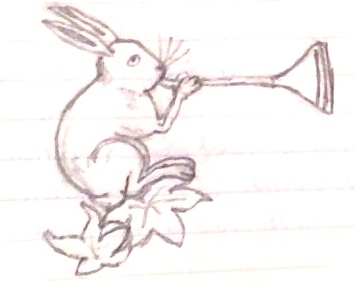Troilus and Criseyde is written in Rhyme Royal. Each verse has seven lines in a rough iambic pentamenter (unstressed syllable, stressed syllable x 5) as in ‘Have here a swerd and smyteth of myn hed!’ (26) and a rhyme scheme ababbcc.
With that she gan hire face for to wrye a
With the shete, and wax for shame al reed; b
And Pandarus gan under for to prie, a
And seyde, ‘Nece, if that I shal be ded, b
Have here a swerd and smyteth of myn hed!’ b
With that his arm al sodeynly he thriste c
Under hire nekke, and at the laste hire kyste. c
But knowing this will not get you very far in a commentary. Instead, you need to focus on analyzing how Chaucer exploits the main features of this form.
The couplet that concludes each verse is particularly important, and can act as a summary or climax for the preceding lines, though not always. Since the caesura in this poem is usually between the second and third stressed syllable, the second stress in the final line can be of marked importance and central to understanding the development of the stanza. Pay attention to the progress of ideas within a commentary passage and how the couplets work within that structure. Since the majority of sentences also conclude with the break between stanzas, you should consider the effect when sentences continue between stanzas.
Rhyme is an integral part of this form and may be important, but since every stanza has rhymes be careful not to over interpret their significance, especially if other features of that stanza do not support your reading. There are some words that are frequently used in rhyming position, bringing out thematic ideas throughout Troilus, such as destresse, peyne and smerte. There are also some cases where the same words are repeatedly rhymed together in Troilus creating meaningful associations. For instance, ‘the collocation of joie with Troye 31 times (23 times in the final couplet of the stanza) develops a particular resonance, ironic and poignant, as the narrative takes its course towards the unhappy end of Troy. The collocation of routhe and trouthe (19 times, 14 in the final couplet), as also of rewe and trewe, begins in the courtly context of Criseyde’s pity on the faithful integrity or trouthe of Troilus as a lover and develops through a sad transformation as Criseyde loses her own trouthe.’ (Windeatt, ‘Style’, pp.358)
Meter may also play a part, though we should not be expecting a slavish adherence to the pattern of unstressed syllable, stressed syllable. It was possible to:
- have a regular rhythm produced by a normal reading: ‘Have here a swerd and smyteth of myn hed!’ (26)
- reverse the pattern of stressed and light syllables: ‘Criseyde answerde, “Never the bet for yow…”‘ (17)
- omit the initial light syllable, producing a ‘headless’ line: ‘Pandare, o-morwe, which that comen was…’ (8)
As well as:
- omit the light syllable after the second stressed syllable, producing a ‘broken-backed’ line that Lydgate favoured
- have an additional light syllable before a natural pause
- have an additional light syllable for no reason
 How does the couplet function in this stanza? Are the words that rhyme particularly significant? Are the words that are linked together in antithesis or complementary? Does one term modify the other? Does any deviation from the pattern of iambic pentameter have poetic effect? That is, does it in some way support or alter the meaning of the text?
How does the couplet function in this stanza? Are the words that rhyme particularly significant? Are the words that are linked together in antithesis or complementary? Does one term modify the other? Does any deviation from the pattern of iambic pentameter have poetic effect? That is, does it in some way support or alter the meaning of the text?
Example
With that she gan hire face for to wrye a
With the shete, and wax for shame al reed; b
And Pandarus gan under for to prie, a
And seyde, ‘Nece, if that I shal be ded, b
Have here a swerd and smyteth of myn hed!’ b
With that his arm al sodeynly he thriste c
Under hire nekke, and at the laste hire kyste. c (22-28)
In this stanza the temporary opposition between Criseyde and Pandarus is emphasised by the rhyme between ‘wrye’ (cover, shield) and ‘prie’ (peer, peep), as Pandarus deliberately intrudes beneath her flimsy protection: first with his gaze, then with his arm and finally with his mouth. The sense of this intrusion is given greater force by the final couplet’s rhyme on ‘thriste’ and ‘kyste’, focusing attention on Pandarus’ activity. Whereas Criseyde is the subject of verbs only in the first two lines, both of which are more passive, to do with covering (‘gan…to wrye’) or changing expression (‘wax’). The opposition between Pandarus and Criseyde is further brought out in his offer to her. It seems too hyperbolic to be taken seriously and the regular iambic pentameter of the line (26) in contrast to the less regular rhythms of the rest of the stanza contributes to that impression. The offer is then immediately undercut by the thrusting of his arm. The final line places particular stress on ‘nekke’ offering a counterpoint to the ‘hed’ that Pandarus said should be struck off for his deception, emphasising Pandarus’ position of control and undercutting any notion of Criseyde truly taking vengeance on Pandarus.
Quick Further Reading
- Barry Windeatt, ‘Style’ in his Oxford Guides to Chaucer: Troilus and Criseyde (Oxford, 1992), pp. 314-59, esp. 354-59
- Simon Horobin, ‘Language and Style’, in his Chaucer’s Language (Basingstoke, 2007), pp.126-49
- Jenni Nuttall, ‘Poetics Primer: How to talk about rhyme’ and ‘How to talk about metre’ on her Stylisticienne blog